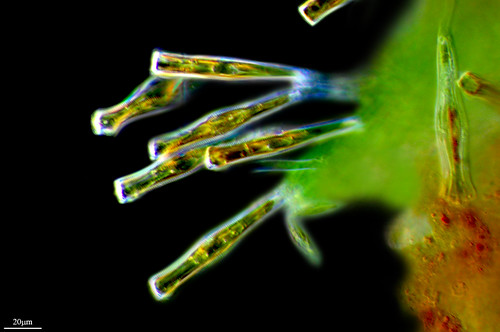科學家發現一種能夠耐受極端環境的單細胞綠藻,將有機會廣泛應用於核電廠排出的放射性液體或廢水處理,而且成本低、不傷害環境。
科學家發現新微藻 可望用於核汙染生物修復
放射性雖能殺死大部分的有機體,但有一種微藻(Coccomyxa actinabiotis)卻有極佳的抗輻射能力,能累積放射性核種,還能忍耐20,000戈雷(Gy)的輻射量。戈雷是電離輻射劑量的單位,定義為每公斤物質因游離輻射照射所吸收的能量。20,000戈雷(Gy)是人體致命劑量的2,000倍,而人體只要接觸到5戈雷以上的輻射劑量,通常會在14天內死亡。
微生物,包括藻類在內,已被廣泛應用於處理核廢料的副產物,但作業花費和設備成本相當高昂,維護工作繁重,也會產生大量的放射性廢棄物。
法國科學家在一座法國核電廠的用過核子燃料冷卻池發現Coccomyxa actinabiotis。研究者分析了這種獨特藻類的特性後,認為很可能成為核汙染的生物修復技術。科學家並在一個小時之內就證明,Coccomyxa actinabiotis和傳統的物化離子交換淨化法一樣有效。
行光合作用清核廢 微藻將更便宜、環保
而最新發現的Coccomyxa actinabiotis nov. sp.微藻,則是可以單就光合作用和代謝過程吸收汙染物質,有機會發展成放射性液體或廢水的處理方案,將更便宜且環保。
科學家們指出,在核燃料儲存池中,Coccomyxa actinabiotis有效地引發了大規模的放射性核素生物淨化反應,「相較於傳統的物化淨化法,核廢料少了許多。」
法國替代能源與原子能委員會(CEA)和勞厄-朗之萬研究院以Coccomyxa actinabiotis進行生物反應器前導研究,進一步驗證生物修復策略可行性,結果發現Coccomyxa actinabiotis生物反應器能有效移除輻射廢水的放射性物質,包括碳-14、鈾-238和銫-137。
A single-celled green alga that can tolerate extreme conditions may soon be widely used to clean up radioactive effluents and wastewater from nuclear facilities in an inexpensive and environmentally-safe manner.
Most organisms are killed by the radioactivity, but the micro-alga Coccomyxa actinabiotis is extremely radioresistant and strongly accumulates radionuclides.
Coccomyxa actinabiotis can resist a radiation dose of 20,000 grays (Gy), about 2,000 times the lethal human dose. The gray is a unit of ionizing radiation dose defined as the absorption of one joule of radiation energy by one kilogram of matter.
By comparison, humans exposed to a fraction of this level of radiation, five or more gray (gy), usually die within 14 days.
Microorganisms, including algae, already are used widely by the nuclear industry to help manage waste by-products. But they have high operating and equipment costs, require heavy maintenance and generate large volumes of radioactive waste.
The discovery of the new alga, Coccomyxa actinabiotis nov. sp., which uses photosynthesis and metabolic processes to take up contaminants, creates the potential to develop cheaper and more environmentally-friendly solutions for decontaminating radioactive effluents and wastewater.
Scientists in France discovered Coccomyxa actinabiotis in a cooling pool for spent fuel at a French nuclear facility. After analyzing the properties of this unique species, researchers now foresee new strategies for the bioremediation of radioactive contamination.
In one hour, the scientists say, Coccomyxa actinabiotis has proved as effective as conventional physico-chemical ion-exchangers in purifying radioactive effluents.
Using this organism, an efficient real-scale radionuclide biodecontamination process was performed in a nuclear fuel storage pool with “an important reduction of waste volume compared to the usual physico-chemical process,” the scientists report.
The CEA and the Institut Laue-Langevin have put together a bioreactor pilot study based onCoccomyxa actinabiotis to provide a proof of concept, which will optimize the bioremediation strategy.
The pilot-scale treatment unit removes highly radioactive effluents, including carbon-14, uranium-238 and cesium-137.








